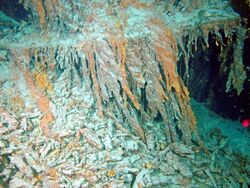Biology:Halomonas titanicae
| Halomonas titanicae | |
|---|---|

| |
| Scientific classification | |
| Domain: | Bacteria |
| Phylum: | Pseudomonadota |
| Class: | Gammaproteobacteria |
| Order: | Oceanospirillales |
| Family: | Halomonadaceae |
| Genus: | Halomonas |
| Species: | H. titanicae
|
| Binomial name | |
| Halomonas titanicae Mann, Kaur, Sánchez-Porro & Ventosa 2010[1]
| |
Halomonas titanicae is a gram-negative, halophilic species of bacteria which was isolated in 2010 from rusticles recovered from the wreck of the RMS Titanic.[1] It has been estimated by Henrietta Mann, one of the researchers that first isolated it, that the action of microbes like Halomonas titanicae may bring about the total deterioration of the Titanic by 2030.[2] While the bacteria have been identified as a potential danger to oil rigs and other man-made objects in the deep sea, they also have the potential to be used in bioremediation to accelerate the decomposition of shipwrecks littering the ocean floor.[3][4]
Cell morphology
Halomonas titanicae is a gram-negative, rod-shaped bacterium that produces peritrichous flagella. It is catalase and oxidase positive. It has been found to form biofilms and some strains are capable of oxidation of thiosulfate, which is regulated by quorum sensing.[5] It is able to withstand high osmotic pressure due to producing molecules like ectoine, hydroxyectoine, betaine, and glycine.[6][7]
Importance in corrosion
Halomonas titanicae is involved in the corrosion of steel by reducing Fe(III) to Fe(II) when oxygen is not available as an electron acceptor. However, when in aerobic conditions, it helps to inhibit corrosion by consuming dissolved oxygen.[8] In the case of the Titanic and other shipwrecks, the bacteria accelerate the corrosion of these structures since levels of dissolved oxygen deep in the ocean are very low.[9]
References
- ↑ 1.0 1.1 Cristina Sánchez-Porro; Bhavleen Kaur; Henrietta Mann; Antonio Ventosa (2010). "Halomonas titanicae sp. nov., a halophilic bacterium isolated from the RMS Titanic". International Journal of Systematic and Evolutionary Microbiology 60 (12): 2768–2774. doi:10.1099/ijs.0.020628-0. PMID 20061494. http://pdfs.semanticscholar.org/4756/a6556ca7a3d1ee919c446c8578be088c18f5.pdf.
- ↑ "'Extremophile Bacteria' Will Eat Away Wreck of the Titanic by 2030". 2016-09-07. http://www.laboratoryequipment.com/news/2016/09/extremophile-bacteria-will-eat-away-wreck-titanic-2030.
- ↑ Betsy Mason (May 24, 2011). "Top 10 New Species Discovered in 2010". Wired. https://www.wired.com/wiredscience/2011/05/2010-species-gallery/?pid=1290.
- ↑ "New species of bacteria found in Titanic 'rusticles'". BBC News. December 6, 2010. https://www.bbc.co.uk/news/science-environment-11926932.
- ↑ Du, Rui; Gao, Di; Wang, Yiting; Liu, Lijun; Cheng, Jingguang; Liu, Jiwen; Zhang, Xiao-Hua; Yu, Min (2022). "Heterotrophic Sulfur Oxidation of Halomonas titanicae SOB56 and Its Habitat Adaptation to the Hydrothermal Environment". Frontiers in Microbiology 13: 888833. doi:10.3389/fmicb.2022.888833. ISSN 1664-302X. PMID 35774465.
- ↑ Du, Rui; Gao, Di; Wang, Yiting; Liu, Lijun; Cheng, Jingguang; Liu, Jiwen; Zhang, Xiao-Hua; Yu, Min (2022). "Heterotrophic Sulfur Oxidation of Halomonas titanicae SOB56 and Its Habitat Adaptation to the Hydrothermal Environment". Frontiers in Microbiology 13: 888833. doi:10.3389/fmicb.2022.888833. ISSN 1664-302X. PMID 35774465.
- ↑ September 6, 2016, Extremophile Bacteria’ Will Eat Away Wreck of the Titanic by 2030.
- ↑ Wang, Yu; Wu, Jiajia; Sun, Liping; Zhang, Dun; Li, Ee; Xu, Ming; Cai, Haoyuan (2021-04-15). "Corrosion of EH40 steel affected by Halomonas titanicae dependent on electron acceptors utilized" (in en). Corrosion Science 182: 109263. doi:10.1016/j.corsci.2021.109263. ISSN 0010-938X. https://www.sciencedirect.com/science/article/pii/S0010938X21000299.
- ↑ "Dissolved Oxygen" (in en-US). https://www.fondriest.com/environmental-measurements/parameters/water-quality/dissolved-oxygen/.
External links
Wikidata ☰ Q287265 entry
 |

